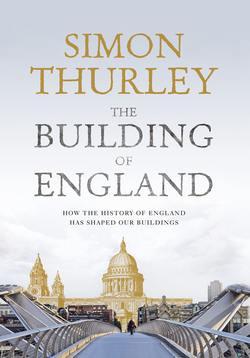Читать книгу The Building of England: How the History of England Has Shaped Our Buildings - Simon Thurley - Страница 23
The Parishes
ОглавлениеThe period after the Conquest saw a huge shift in wealth from secular hands to the Church, a shift in landownership not equalled again until the reverse took place under King Henry VIII. Thus Norman landowners such as Robert and Beatrice, the landlords of Asheldham, Essex, endowed their church of St Lawrence by transferring its patronage to a local priory at Horkesley with sixty acres of land. Many such gifts were stimulated by the penitential ordinance of Easter 1067, which set out the penances owed by William’s men who had killed and maimed on English battlefields. Those who were unclear how many English they had slain had a choice: they could either do penance one day a week for life or endow a church. If you were rich the choice was easy.17
This lent additional momentum to the rebuilding of timber churches in stone that had started around 1000 (p. 68). At Asheldham the timber church was replaced, the main street diverted and a burial ground formed. Asheldham church has now been rebuilt, but a small number of churches rebuilt soon after the Conquest have been preserved largely unaltered because of later depopulation. Such churches vividly capture the everyday experience of worship in the years immediately after the Conquest.
Fig. 43 Winchester Cathedral, plan at tribune (first floor) level. The cathedral, begun in 1079, had many affinities with its Saxon forebears: there were altars in the galleries and a tribune or royal pew at the west end. Spiral stairs led up to the gallery at several points. + indicates a side altar.
Fig. 44 Winchester Cathedral; the north transept. This precious surviving unaltered part of the cathedral shows the raw simplicity and power, almost crudeness, of the early Norman cathedral.
Fig. 45 St Margaret’s, Hales, Norfolk. This lovely church has a Saxon round tower that was heightened in the 15th century, but its nave and apsidal chancel date from the early 12th century.
Fig. 46 St Botolph’s, Hardham, West Sussex. The wall paintings here, done in 1120–30, were covered up in the 13th century and only re-discovered in 1866.
Most of these are two-roomed (or, more correctly, two-celled), with rectangular naves separated from the chancel by an arch. Most chancels originally had an apse but almost all were later rebuilt square-ended. In east Norfolk a couple of remote churches still retain their original apse, and perhaps the best among these is St Margaret’s, Hales. The round tower is later, but the apsidal chancel dates from before 1130 and retains some of its blank arcading (fig. 45).18 Another group of well-preserved churches is in West Sussex. St James’s, Selham, could be Anglo-Saxon; its masonry and carving are clearly by Anglo-Saxon hands, although the likelihood is that it was built just before 1100. St Botolph’s, Hardham, miraculously retains its wall paintings of about 1120 that were whitewashed over and only rediscovered in 1866. The murals, painted in ochre and yellow, a typical Anglo-Norman bacon-and-egg palette, show St George slaying the dragon (the earliest such image in Britain), and wonderful figures of Adam and Eve (fig. 46). The halos are painted in green paint made by coating copper plates in urine and sealing them in a container for two weeks.19
Although these small Norman churches are sometimes almost indistinguishable from their Saxon predecessors, the difference was the discipline that the Normans sought to bring to parish life. Lanfranc’s reforms subdivided dioceses into archdeaconries and deaneries to give greater supervision to individual parish priests. This was important, as most priests before 1000 were in minsters under close supervision; with the proliferation of local churches there were now hundreds of remote priests, poor, ill-educated (often illiterate), undisciplined and isolated. Some were drunkards, some said Mass armed, others had secular employment and many had wives. Almost all were English. Under the new regime more was demanded of them and greater discipline enforced. The life of the average clergyman was transformed in the century after 1066.20
